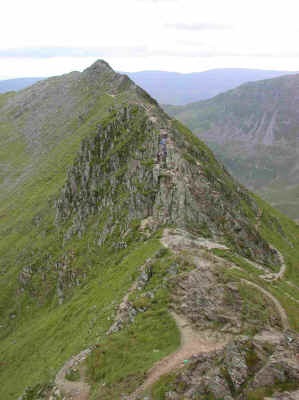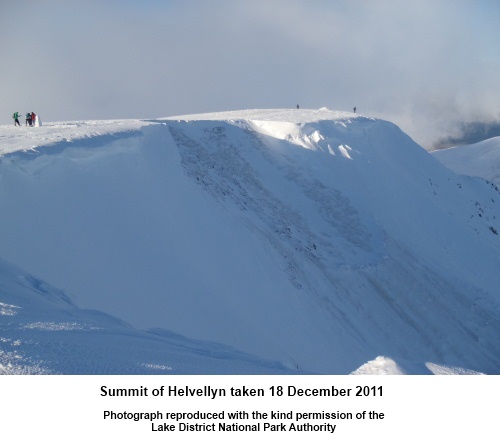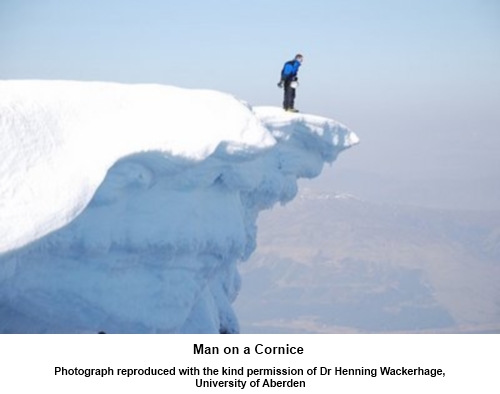|
Safety
Much of being safe is common
sense. Hopefully, reading this section will help avoid mishaps but if you
have a genuine emergency situation and rescue is the only option, see what3words.
Note "emergency" does not mean you have forgotten your sandwiches!
Emergency call outs affect and can risk other peoples lives.
You must be properly equipped (see
Choosing
Equipment). The harsher the conditions either due to altitude
or season, the more important this becomes. Pretty can become perilous very
quickly.
Do not underestimate the
debilitating effects of walking into a strong wind which will be exacerbated
by rain/snow/hail. Bear in mind the effects of wind chill. In still air a
temperature of 0º C feels like 0º C. If there is a wind of ten knots
(which is only classed as a gentle breeze) it will feel the same as -5º C.
At 25 knots (a fresh to strong breeze) the effect falls to -12º C.
If your clothing gets wet, the effect is worse. The wind can also make you
veer off course. Put waterproof clothing on sooner rather than later.
I have seen people walking up
Striding Edge in the Lake District in denim jacket and jeans, trainers, no
waterproofs and only a bottle of Coke as provisions. AND, it
was raining! This is foolhardy in the extreme and as well as creating
personal risk, also potentially risks the safety of rescuers.

Do not attempt exposed ridge
walks in high winds. Whatever wind effects you can feel at low level, they
will be magnified at altitude. Ideally if conditions are poor, abandon the
walk. The mountain will still be there tomorrow.
Do not tackle snow/ice covered
mountains unless you have crampons and an ice axe and know how to use them
If on a snow covered mountain,
be very wary of approaching an edge. Snow may have blown into an overhanging
cornice which from the surface looks solid but through which you can fall
with ease!
Take sunglasses especially in
snowy weather or snow goggles to combat glare. These can also be useful if
walking into a hail storm.
Check the weather before you go.
See:
Striding Edge
If you are responsible for
leading a group, do not assume everyone is properly equipped. Find
out.
You can see various sources
about conditions in various areas on my Links
page.
Walking Times
A crucial element of safety is
not attempting something which is beyond your or your group's capabilities
or endurance. You might sometimes see 4 mph quoted as walking speed. On a
flat pavement, this is an impressive pace and not one you are likely to
achieve cross country and certainly not uphill. In this context a useful
guide to how long a walk may take is the walking time calculator known as Naismith's Rule. Naismith, a mountaineer,
originally stated you should assume a speed of "3 M.P.H. + 1/2
hour for every 1000 ft. climbed". He was however a very fit walker!
To convert this to take account
of metric maps, the equivalent is 1 minute for each 10 meters of height
gain, plus the time for linear distance. To assess height gain, count the
contour lines (check that the contours are 10 meters apart). Add this to
your overall time. Some people also add time for descent on the basis of 1
minute for each 20 meters of descent of average descent.
Speed across the ground
otherwise depends upon the terrain, the weather, how many photographs you
stop to take, lunch stops etc. Your speed is likely to be between 1.9 and 3
miles per hour (3 and 5 km
per hour) but only experience will tell you. Assume slower speeds initially
and especially allow for short winter days.
If you want to give it a try,
you could use my Walking
Time Calculator based on Naismith's Rule, with adjustments.
Use the map to monitor your
progress against your route. This will show you how far you have walked and
more importantly where you are and how far to the finish. It is worth
working out compass bearings from strategic points on a walk (e.g. from a
trig. point) before a walk and writing them on a piece of paper to
slip into your map case. It is much easier and with less chance of error to
do this in the comfort of your home/car than in a howling gale with the rain
beating down on a mountain top!
Take a watch, especially in
winter, and note the time when you set off and periodically as you walk so that progress
is monitored against available daylight. Avoid walking in the dark, even
with a good torch. The harsh light plays tricks with shadows, hollows and
rocks and you could easily trip.
If possible, do not walk alone.
If walking with a group,
especially if planning a fairly severe walk, it is worth having an early
escape route (short cut) in mind if the weather becomes inclement or any member of your
party becomes exhausted. The group should always walk at the pace of the
slowest and stay together, or at least no-one should be alone out of sight
of other group members. If the group becomes "strung out", stop
periodically to allow everyone to catch up and make sure all are accounted
for.
You may see advice to the effect
of leaving a note in your car of your intended route, expected time of
return etc. Unfortunately in modern times, this effectively tells a car
thief how long he has to steal your car or contents. However, if staying in
hotel/B & B, it would be worth advising them. Perhaps tell a friend.
In the mountains, beware of
avalanches after snowfalls. The photograph below shows the aftermath of a dramatic avalanche on
Helvellyn. Anyone beneath it or stood on top at the crucial moment would
probably have come to a sticky end. As you can see, the snow projected a
considerable distance from the actual edge of the summit. Beware!

Beware also of cornices (overhangs) of snow on
to which you might walk and fall through or which might snap off. The
photograph below is a scary example of an accident waiting to happen! The
individual probably did not realise what was (or was not!) beneath.

If visiting Scotland, see the Scottish
Avalanche Information Service
Never get between a horse/cow
and its young and never surprise an animal especially from behind. If you
are not certain the animal has seen you say something to alert it -
"Hello Mr. Horse" will do.
If you are walking with a dog,
this can spook cows, especially with young. If they charge, they will be
chasing the dog. Abandon the dog. You will not outrun them but the dog will.
I have heard it said that a cow will not charge a person against a wall as
they know a wall hurts! I have never had to try this out!!
If faced with a steep climb or
descent where you have to use your hands, pack away walking poles, cameras,
GPS receivers etc to leave your hands free. Always try to choose your routes
so that steep rock scrambles are dealt with as an ascent rather than a
descent as this way you can see where you will put your feet. If forced to
descend, treat it as you would a ladder and come down backwards so that the
maximum area of your foot is available for purchase.
Finally, an almost silly safety
issue - until it happens! Some laces on boots are quite long so that when
tied in a bow, even a double bow, a large loop results. It is very easy for
this loop to catch in the lugs on the opposite boot as you walk resulting in
a very unexpected and incredibly fast headlong meeting with the ground (as
my wife can testify - and it hurts - she got the cuts and bruises to prove
it!!!). Either shorten the laces, tie them in a triple or even quadruple
bow to keep the loops small or tuck them in somehow.
Emergencies
A mobile phone can be invaluable
to summon assistance. Make sure it is fully charged and preferably (and to
maintain the peace of the countryside) keep it switched off to conserve the
power until you need it. Mobile phone signals can be erratic in remote
country, steep valleys, gorges or mountains. You need line of sight to the
mast. It could be that climbing to a more exposed spot will increase
reception chances.
The various mobile phone
companies publish maps which show coverage but these cannot identify
individual black spots. Mobile companies have agreed to field each others
emergency calls so the fact you do not have a signal from your own provider
may not prevent an emergency call.
Dial 999 (in the UK) or 112
(anywhere else or indeed the UK - it is an international agreement) and ask for
the police who will contact the relevant mountain rescue organisation. In
the UK, this is a free service run by volunteers but beware that in some
places abroad there can be significant costs against which you might want to
insure. Find out before you go. Ask for police not ambulance as the
ambulance service currently require a postcode to function - the Ramblers
are currently campaigning to get the ambulance service to be able to respond
to OS references. The police will call out the nearest mountain rescue
service. An accurate description of your location (preferably an Ordnance
Survey reference) is obviously preferable.
A new service has been
launched for those who carry a mobile phone. Called What3Words,
There is now an Emergency
SMS Service which is for deaf, hard of hearing and speech-impaired
people in the UK to text messages to the UK 999 service. It will be passed
to the police, ambulance, fire rescue, or coastguard as appropriate. You
must register your phone with them first.
Know where you are through
monitoring progress on your map. You can then provide an exact location and
OS reference. A GPS reading is also useful.
The UK mountain distress signal
is six steady blasts of your whistle (or six torch flashes at night), wait
for one minute and repeat.- keep doing this until you are found. The
response is three flashes or blasts of the whistle, pause for one minute
then three again.
If there are three or more in
the party, one should stay with an injured person, while the other plots the
exact location, notes the injuries and goes for help.
If a rescue helicopter is in sight and
you need its assistance, raise your arms imitating a "Y". If you
do not need that assistance and it looks like landing, one arm down and the
other up imitating a "N" is the signal.
Ticks
If you find a tick attached to
your skin, it is important not to brush it off and leave the head nor
should its body be squeezed, to avoid the risk of infection. It should be
removed with a fine pair of tweezers or a special tick removing tool. Lyme
disease can be spread by ticks. Symptoms can be wide ranging, so if you feel
in any way unwell after being bitten or have any unusual symptoms, seek
medical advice. Further information is available at: www.lymediseaseaction.org.uk
and a Publication from Public Health
England.
All information on this
site is given in good faith and no liability is accepted in respect of any
damage, loss or injury which might result from acting on it.
|
